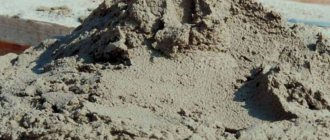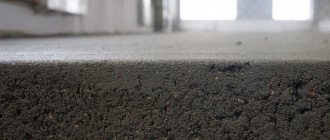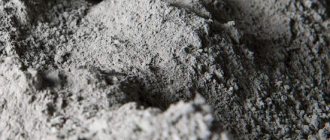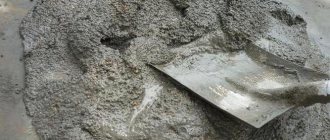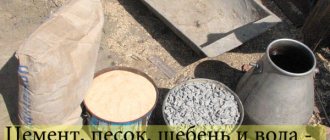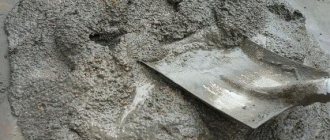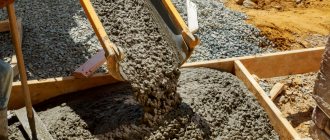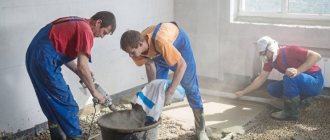In modern construction and renovation procedures, cement powder is practically never used in its pure form. Solutions are prepared using a binder with the addition of a number of other building materials (primarily sand) and modifiers. The process of high-quality preparation and the scope of application of each mixture (dry construction mixtures with cement) are strictly regulated on the basis of the current state standard 28013-98.
Within the framework of this documentation, the following types of solutions can be distinguished (depending on their intended use during operation):
- installation and masonry consistency;
- facing compositions;
- a range of plaster facing mixtures.
The actual compressive strength for each of the solutions is determined by its belonging to one of the brands:
- low-strength - from M4 to M75;
- with average strength indicators - M100 and M150;
- especially durable - the most common is M200 and more.
As part of the manufacturing procedure, a binding material is used - Portland cement (PC) or slag Portland cement (SPC). The filler for powdered Portland cement clinker is always sand selected according to GOST for construction procedures.
Types and areas of their use
Universal dry mixtures differ in composition and purpose, they have their own characteristics and characteristics.
You should pay attention to the marking, the number in which indicates the strength of the original product
M100
M100 products are intended for manual plastering and putty. The mixture is applied in an even thin layer, which leads to material savings. She is easy and pleasant to work with. The mixture retains its properties for two hours from the moment of dilution. Prices for M100 products are quite affordable.
M150
M150 products are the most popular of the varieties of universal mixtures. It is used in virtually all construction work using dry compounds. Unlike M300 and M400, it is used for masonry, plaster, and screed. Factory packaging is presented in 50 kg bags, less often they produce products in 25 kg packaging.
The universal mixture includes Portland cement, sand, mineral powder, plasticizers and other additives. The finished composition can only be diluted with cold water in the proportion indicated on the package.
M150 products are endowed with many advantages: they are reliable, frost-resistant, have good adhesion to various surfaces, high moisture resistance and vapor permeability. It is used in any climatic conditions.
The disadvantages of M150 include poor resistance to increased loads (no more than 150 kg per 1 cubic cm), therefore such a mixture is not used for work with the foundations of multi-story buildings.
The name “universal” speaks of the variety of applications of the M150 composition.
- The plaster mixture is designed for interior and exterior plastering work. Layer thickness can be applied up to 50 mm. After mixing, work should begin immediately: the mixture is in a pliable state for 2 hours. The plaster becomes completely dry and strong after 4 weeks.
- Using the M150 screed mixture, the floors in the rooms are leveled. Checking the level and setting the beacons, the floor is poured with a thickness of 1 to 10 cm. Thanks to the cement base, the floor acquires durable qualities that are resistant to temperature changes.
- The masonry mixture is used for laying gas silicate blocks and bricks of all types. M150 products can be used indoors and outdoors in cold or hot weather; weather conditions do not affect the quality of masonry. The dry mixture has proven itself well in rooms with high humidity.
M200
Product M200 is a masonry mixture. It consists of Portland cement, river sand and special additives. Designed for laying bricks, concreting flooring, constructing simple foundations, repairing walls and processing seams in concrete structures.
M200 can be used for laying garden tiles, as well as for plastering and puttying walls. It is available in bags weighing 50 kg.
M300
Sand concrete M300 appeared on the construction market not long ago, but has already gained popularity. Unlike the M150, it is designed for heavy loads. The products are durable and reliable, have a long service life, adapt well to weather conditions, are moisture resistant, environmentally friendly, and do not shrink. M300 consists of Portland cement, which contains gypsum, sand and crushed clinker. Products are packaged in 50 kg bags, less often in 200 kg bags for industrial scale.
Due to its special strength, the composition is used in all areas of construction work in all climatic conditions. During installation, they are used to install the foundation, floor screed, leveling walls and other surfaces. The product has proven itself well as a grout for cracks during work at emergency sites. The composition is used when laying garden paths, stairs, and borders. The mixture is used in the production of expanded clay concrete.
According to their properties, depending on the application, M300 products are divided into several subtypes.
- Coarse grain has incredible strength and long service life. With its help you can fill the foundations of high-rise buildings.
- Medium-grain is used for screeds, self-leveling floors, work with borders and garden paths. It is used wherever a medium-grained fraction of the mixture is required.
- Fine-grained is also reliable and durable; it is used for plastering work.
When choosing a universal dry composition, you should remember: the more famous the brand and the higher the grade of the product, the more expensive the product and the more reliable its technical properties.
For information on what dry building mixtures are, see the following video.
Some manufacturers and material costs
Dry masonry, masonry and universal cement mixtures of the M100 brand are sold in Russia by many manufacturers of building materials, for example Resolit, SiLix, ALMI. In May 2022, the price for a bag weighing 25 kg is about 100 rubles.
There are compounds on sale with a compressive strength of 10 MPa, but not marked for this parameter (price per 25 kg):
- Found Brickform MS 11 white and color - 310 rubles;
- Found Brickform MS 11/1 color with high water absorption - 360 rubles;
- Stroybrig Colored Kipirok - 215 RUR. and etc.
Ready-to-use cement masonry mortar M100 can be purchased from almost any company involved in the production of concrete. Price per 1 m³ - from 2500 rubles. The cost of materials is indicated for approximate calculation.
Specifications
The technical characteristics of sand concrete determine the rules of its operation and resistance to external destructive factors. The composition and technical properties of the M300 mixture make it possible to use it both as a self-leveling compound (self-leveling mixture) and as a repair composition.
Compound
Any variants of M300 mixtures are gray in color. Its shades may vary depending on the composition. For such materials, Portland cement M500 is used. In addition, the M300 mixture, according to GOST, has the following proportions of the main components: one third of cement, which is the binding ingredient, and two thirds of sand, which is the filler.
Frost resistance
This indicator indicates the ability of the material to withstand multiple temperature changes, alternating thawing and freezing without severe destruction and reduction in strength. Frost resistance allows the use of M300 sand concrete in unheated places (for example, in permanent garages).
Frost resistance of mixtures with special additives can be up to 400 cycles. Frost-resistant repair mixtures (MRMs) are used for mixing construction compounds used in the reconstruction and restoration of concrete, reinforced concrete, stone and other joints, filling voids, cracks, anchors and for other purposes.
Compressive strength
This indicator helps to understand what tensile strength a material has under static or dynamic influence on it. Exceeding this indicator has a detrimental effect on the material and leads to its deformation.
Dry mixture M300 can withstand compressive strength up to 30 MPa. In other words, given that 1 MPa is approximately 10 kg/cm2, the compressive strength of M300 is equal to 300 kg/cm2.
Temperature range
If the thermal conditions are observed at the time of work, the process technology is not disrupted. The continued preservation of all the performance qualities of concrete is also guaranteed.
It is recommended to carry out work with M300 sand concrete at temperatures from +5 to +25? C. However, sometimes builders are forced to violate these recommendations.
Adhesion
This indicator characterizes the ability of layers and materials to interact with each other. Sand concrete M300 is capable of forming reliable adhesion to the base layer, which is equal to 4 kg/cm2. This is a very good value for dry construction mixtures. To ensure maximum adhesive performance, manufacturers provide appropriate recommendations regarding preliminary preparation work.
Bulk density
This indicator means the density of the material in its uncompacted form, taking into account not only the volume of particles, but also the space that has arisen between them. This value is often used to calculate other parameters. In bags, the M300 dry mixture is in bulk with a density of 1500 kg/m3.
If we take this value into account, it is possible to draw up an optimal ratio for construction. For example, with the declared density, 1 ton of material is 0.67 m3 in volume
In small-scale construction work, a 10-liter bucket with a volume of 0.01 m3 and containing about 15 kg of dry mixture is used as a measure of the amount of material.
Sand particle size
Factories produce M300 sand concrete using sand of different fractions. These differences determine the peculiarities of the technique for working with the solution.
There are three main sizes of sand used as raw material for dry mixtures.
- Small size (up to 2.0 mm) – suitable for street plastering work, leveling seams.
- Medium size (from 0 to 2.2 mm) – used for screeds, tiles and borders.
- Large size (more than 2.2 mm) – used for pouring foundations and foundations.
Mixture consumption
This indicator characterizes the material consumption with a layer thickness of 10 mm per 1 m2. For M300 sand concrete it is usually in the range from 17 to 30 kg per m2. It is worth noting that the lower the consumption, the more economical the work costs will be. In addition, manufacturers often indicate the consumption of sand concrete in m3. In this case, its value will vary from 1.5 to 1.7 t/m3.
Delamination
This indicator characterizes the connection between the lower and upper parts of the solution. The M300 mixture usually has a delamination rate of no more than 5%. This value fully complies with the requirements of the standards.
Transportation and storage
Dry mixtures for preparing masonry mortars M100 are transported in plastic bags or paper bags. A quality document is required. The shelf life of the mixture is 6 months. After its expiration, the grade of material in terms of compressive strength decreases. This composition is suitable for use, but only when installing structures with low load-bearing capacity requirements. The finished solution is delivered to the buyer in a car equipped with a concrete mixer, or less often in bunkers. It is used immediately.
Storing cement in bags.
What is sand concrete made of?
The characteristics of sand concrete m300 (composition, proportions 1 m³) are standardized by GOST 7473-94.
High-quality dry mixture contains:
- Portland cement PC500 D20/PTs400 D0;
- fractionated dry sand, with a combined composition of fractions (particle size 0.80-4.0 mm);
- other additives (frost-resistant, microsilica, fiberglass) are introduced at the discretion of the manufacturer.
Sand concrete M300 can be used to construct wear-resistant, high-strength floors as a load-bearing covering in utility and residential premises, including garages, basements (with a load of 250-300 kg/cm²)
Depending on the sand used, M300 grade material is used to carry out certain work:
| Sand, particle size, mm | Characteristic | Application |
| Small – 0.80-1.20 | High wear resistance and strength characteristics | Carrying out critical masonry and other external work, light floor screed 50.0 mm, installation solutions of increased strength |
| Average – 1.80-2.20 | Increased resistance to operating loads | Implementation of interior work, laying curbs, paving slabs, erection of Euro fences, screed up to 100 mm, “warm floor” systems |
| Large – 2.50-4.0 | Moderate moisture absorption | Construction of slab, strip and column foundations, plinths, pit floors, without restrictions on thickness using reinforcement |
How to calculate the volume of materials for screed
To calculate the required amount of building materials, it is necessary to determine the cubic capacity of the mass used for pouring. It's simple: multiply the area of the room by the number of centimeters of the poured mass. The layer is usually about 10 cm, rarely up to 30, definitely no more.
So, pouring a screed with a layer of 10 centimeters on an object with a floor area of 100 m2, you will need to use 10 cubes of the diluted mass. In order to prepare such a volume, you may need from 555 to 715 kg of CPS (depending on the brand and the required strength of the solution).
Composition of sand concrete m200
The composition of sand concrete is determined by GOST 31357 - 2007 “Dry mixtures for construction with a cement binder”. Each manufacturer can make small additions to the composition of the mixture, but there are key components and indicators that are standard.
Main components:
- Cement m400;
- Sand;
- Crushed stone;
- Water.
When creating, Portland cement M400 is mainly used; it is one of the most common, and its technical characteristics meet all specified standards. Sand is used in two types of fractions - fine-grained and coarse-grained, thoroughly cleaned of foreign impurities.
The composition and proportions of sand concrete m200 per 1m3 according to construction standards, the mixture consumption is:
- Portland cement - 265 (1 part);
- sand 860 (2 parts);
- crushed stone 1050 (5 parts);
- water 180 (? parts).
Specifics of preparing cement-sand compositions
Professionals recommend paying attention to the following points during the cooking process:
- uniform mixing of components;
- preliminary sifting of ingredients;
- compliance with kneading technology;
- moisture content of the feedstock;
- quality of the components used;
- correct administration of additives.
Preparation of a cement mixture is a responsible process that determines the final quality.
Tips and tricks
When planning to prepare a cement-sand mixture, you must immediately decide in what proportion the different components will be taken, what grade of strength is needed, and what the main properties are.
It all depends on the scope of application of the mortar - so, if M50 or M75 is suitable for brickwork, then for screed prepare at least a mixture of M150, 200 and higher. The composition of any CPS includes cement, sand, water, but the result is different depending on the ratio.
Some tips from the experts:
- To prepare a plastic mixture, you can add liquid soap to the solution, previously thoroughly mixed with water.
- You need to know how to properly dilute cement and other components: first, all the dry substances are mixed, then water is added in small portions so that you can control the thickness of the mixture and achieve the ideal consistency.
- When preparing, take into account the brand of building material from which the walls are built. It is desirable that the parameters coincide - then the wall will have a homogeneous structure, reliable and durable.
- Before you make your own cement for plaster, you should take care of purchasing perlite. If you replace some of the sand with it, you will be able to achieve higher thermal insulation characteristics.
- For work, we use exclusively fresh cement, without lumps, produced according to technology and stored in optimal conditions - in this case, it will be possible to achieve the most uniform mixing and high adhesion.
- Detergent or soap is also added to the cement (the proportions remain the same, it is simply mixed with mixing water) to increase adhesion.
- The solution is best prepared in a container made of metal, plastic or wood.
- To thoroughly clean the sand from impurities that can reduce its strength, you can soak it in water for a short time.
- The consistency of the finished cement-sand mixture is usually checked with a trowel: the solution should be distributed evenly over the tool, but not run off (it is worth remembering that this rule works in the preparation of standard mixtures; for some tasks other properties may be important).
- The finished DSP is used for an hour after mixing, until the solution begins to thicken and harden. Therefore, you need to immediately prepare the required volume - exactly as much as you can produce in an hour.
- It is forbidden to dilute an already hardened solution with water, as it immediately loses its properties and can cause destruction of the structure/building.
- When mixing a mixture in a volume greater than 2 cubic meters, no drills or attachments will help - only a concrete mixer or ordering the required volume at the factory.
- The solution, which is planned to be used where minimal loads and low mass are noted, can be prepared with a reduced volume of sand. But this approach is only possible on the condition that before properly mixing the DSP, the master has precisely determined the specifics of the application and the remaining solution will not be used for the implementation of any other tasks.
- Mixing the cement-sand mass should last at least 20 minutes - this way the solution will be homogeneous and of high quality.
- The ratio of the proportions of the components is looked at in GOSTs and SNiPs (the opinion of experienced craftsmen is allowed), as well as in the recommendations of the manufacturer of cement, dry mix, etc.
Cement-sand mixture is a universal material that can be used to perform a whole range of works, obtaining the most durable and strong structures. Provided you select high-quality materials and follow the technology for preparing the mixture for the task at hand, everything can be accomplished quickly and easily.
Purchasing from AlfaCem
We strongly recommend that you coordinate all your actions with expert advice from our blog. Construction takes on new opportunities depending on how professional you are and the quality of the products.
Our products are manufactured at the best domestic and foreign factories. We present only original building materials from suppliers. Based on GOST testing, materials and products are certified.
Leave a request through our online store, or call one of the numbers in the “Contacts” section. The company's managers promptly respond to each request, informing about the availability of the selected product, as well as telling about the conditions under which payment and delivery are made (all of Russia and its regions are served). Follow the news to learn about discounts and promotions from AlfaCem in a timely manner. Be sure to leave your feedback on all aspects of the activity. Waiting for you!
Peculiarities
Dry mix M-300 is a ready-made masonry mixture, the components of which are selected in the required proportions. Before use, the composition is diluted with water in the volume specified by the manufacturer and mixed mechanically until smooth.
The mixture is sand concrete, since it is based on purified fine-grained concrete and Portland cement. The dimensions of the first do not exceed 3 mm; the Portland cement used has a grade strength of M-400 or M-500). To ensure certain characteristics (frost resistance, moisture strength, and so on), plasticizers are introduced.
Various reinforcing fibers may be present in compositions operated at subzero temperatures. To improve adhesion, a special type of clay, coarse sand, or granite chips are sometimes added.
Unlike conventional concrete mortars, M-300 sand concrete is distinguished by its ease of preparation, plasticity (suitable for laying in a thin layer, which is necessary for certain types of masonry), high strength, and economical consumption. The M300 mixture is a masonry mixture, that is, it is used for fixing bricks or masonry stones. In addition, it can be used as a concrete mixture for casting.
The composition is characterized by non-shrinkage, which allows it to be used as a floor screed. And thanks to its increased strength and wear resistance, the mixture is used even when organizing high-strength floors. The thixotropy of the composition allows it to be used also for leveling floors, as well as sealing cracks in concrete surfaces.
The material is suitable for both private housing construction and the construction of industrial and administrative facilities, as well as the installation of basements and garages. It is used when pouring the foundation, including in places where concrete and reinforcing sections meet. The mixture is also used to create paths in private suburban areas. In its properties, the material resembles fine-grained concrete, therefore it is used both outside and indoors.
Scope of application of M100 brand solution
In addition to its main purpose, cement masonry mortar M100 is suitable for use for the following purposes:
- grouting;
- installation of partitions, columns, partitions;
- pouring floor screed;
- filling joints between heavy panels, concrete blocks;
- plastering of concrete surfaces;
- installation of ordinary lintels up to 2.5 m high;
- installation of the underground part of the brick foundation;
- arrangement of flat roofs;
- laying tiles, mosaics.
If a ready-to-use mixture is needed for plastering work, then lime can be added to its composition at the buyer’s request.
General information
A characteristic feature of concrete is its composition, as well as proportions and preparation technology. It consists of cement, fine and coarse fillers, water and various additives. In addition, there are brands of concrete that do not contain coarse filler. There are different mixtures that are used for specific cases and also have different properties.
Designation and its interpretation
Concrete structures gain full strength within 6 months, and in 30 days concrete gains 70% strength. M300 is used in all structures that are subject to significant load, therefore, one of the main indicators is its strength. The MXXX designation template does not indicate a specific brand, but is an indicator of the maximum compression pressure.
In addition, there are other designation patterns, for example, FXXX and WXXX, indicating frost resistance and water resistance, respectively. The M300 class of concrete shows the totality of all grades whose ultimate strength is 300 kgf/sq.m. cm. The tensile strength is tested in laboratory conditions by applying force to parallel planes of a product cast from concrete, in the shape of a cube with a side of 150 mm. The grade of concrete in terms of strength is correlated with its class. These indicators should be selected for the construction and calculation of the finished structure at the maximum load that it can withstand.
M300 corresponds to class B22.5 with a coefficient of variation (CV) that is 13.5%. It shows the homogeneity of the mixture from which any brand of concrete is made. When this coefficient changes, the grade of concrete will also change, that is, if its value is low, the grade will increase and vice versa. If the concrete is M300, then with different values of the coefficient its class will change:
- At Kv = 5% the class is B25.
- At Kv = 13.5% - B22.5.
- At Kv = 18% - B15.
Main characteristics
Concrete is classified into grades, and this distribution is primarily related to the parameters of strength (B), density (D), water resistance (W), frost resistance (F) and workability (P). One of the best options for most construction work is M300 concrete, the characteristics of which are as follows:
- Strength: B22.5 with an indicator of 295 kg/sq. cm.
- Specific gravity of concrete M300: 1800−2500 kg/cubic. m.
- Water resistance: W6-W8.
- Frost resistance: F200-F300.
- Mobility: P2-P4.
The strength indicator is the main characteristic and shows the maximum effect of forces during compression, at which the structure collapses. The specific gravity or density of M300 concrete depends on the type of coarse filler included in its composition. When using limestone, the D value is about 1800 kg/m3. m., and when using harder rocks (crushed granite, granodirite, etc.) it can reach a value of 2500 kg/cubic. m. Due to its high density, this type is classified as heavy. The density indicator depends on the presence of violations in the manufacturing technology and air cavities.
Water resistance (WXX) is a value indicating the water pressure in MPa to pass through 0.15 m of concrete. For concrete grade M300, this indicator is equal to W5-W6; at a pressure of 0.5-0.6 MPa (approximately corresponding to 5-6 atmospheres) it does not allow water to pass through at all. By adding hydrophobic cement, additives and carefully compacting the solution, it is possible to increase the waterproof rating.
Frost resistance is indicated in the form of the FXXX pattern and shows the number of defrost-freeze cycles without loss of strength. This characteristic can be increased in several ways:
- The use of additives that prevent the formation of air bubbles.
- Removing air from the concrete mixture using vibrators, as well as using various compactors.
- Reducing the amount of water (impairs mobility).
- Using solid fillers instead of crushed limestone.
Application in construction
Since M300 has good strength, frost resistance, water resistance and mobility, it is widely used in construction. In addition, its main indicators can be adjusted by changing the components included in the concrete mixture. It is advisable to use it for the following work:
- Construction of platforms, roads and curbs.
- Installation of walls and various supports.
- Construction of stairs, landings and pouring of foundations in multi-storey buildings.
- Production of reinforced concrete products and fences.
- Production of sewer pipes that are constantly exposed to moisture.
- Construction of objects that are affected by constant temperature changes.
Percentage of cement
There are three variations of mixtures:
- Fatty - less than three parts of sand are taken for one part of cement. It is necessary to use only high grade material, otherwise cracking may occur.
- Normal - the standard option for most construction work. In such a mass, the ratio of sand to cement is usually 3-5 parts to one.
- Skinny - a lot of sand granules, usually no less than 5:1. The composition dries slowly, and after a while the mass may crumble, and to prevent the problem it is important to use high-grade Portland cement.
The more cement powder in the cement plasterboard, the less time it takes for the solution to completely harden.
How to prepare TsPS?
Each ready-made mixture must be accompanied by instructions on the required amount of water; other components are usually not provided. When used as part of additional materials (dyes, reinforcing fibers), the proportions must be observed strictly in accordance with the instructions for the additive. The typical ratio of mixture to water is 5 to 1 (a bucket of water per 50 kg bag of mixture), the share of dyes is 0.1%, the share of fiber fiber is 1%.
When making it yourself, the proportions of water and sand to cement are taken depending on the type of work being carried out, strength requirements, and the degree of moisture content of the sand:
1. The thickest mortar required for masonry is the water/cement ratio of no more than 0.8.
2. For screed and plaster, sour cream-like compositions with a W/C ratio of 0.8–1.2 are used.
3. When spraying and grouting, dilute the solution even more, up to W/C - 1.5.
4. Mixtures with W/C less than 0.6 are used when it is necessary to obtain a quick-drying high-grade cement-sand mortar (M300 and higher), or for concrete.
If a concrete mixer is used for mixing, it is recommended to carry out the work in the following order:
- Pour water into the untwisted drum and add additives.
- Add 2 buckets of sand.
- Add a bucket of cement and wait for it to mix.
- Add the remaining sand and add water if necessary.
When kneading by hand, water is poured into the dry mixture. If you do the opposite, water forms a film of cement on the surface of small lumps of the mixture, which will slow down the process many times over. If the composition is made from its own components, it is advisable to mix them dry before adding water.
Once prepared, the solution must be used before it begins to harden - from 15 minutes to several hours, depending on the use of additives, cement concentration and temperature. The usual solution M150-M200 at a temperature of 20 ° C begins to harden an hour after mixing.
Consumption
To plan the mass of the CPS in advance, you need to approximately calculate the required volume of solution and multiply it by the cost per 1 m3 indicated in the description of the mixture. Most often they are indicated in the format “mixture consumption per m2”, meaning a layer 1 cm thick. To get the costs per 1 m3, just multiply the indicated value by 100.
The usual consumption values for sand-cement mixture are 1800 kg/m3, for high-quality compositions - up to 2200 kg/m3, for lightweight plasters with lime - 1200-1600 kg/m3.
Calculating the volume of consumption of mortar for plastering work and screed is not particularly difficult, but the cost of material for masonry depends on the skill of the particular performer. If you strictly follow the technology, the solution consumption will be 25% of the total volume of the wall, but in practice this value can be either up to 35% (thick seams, losses due to splashes) or below 20% (waste masonry, use of poor-quality techniques to speed up work ).
Cement-sand mixtures - common brands
Let's consider cement-sand mixtures of the most common brands:
- M100 is the cheapest mixture. It is used for external and internal plastering, as well as leveling the floor and sealing uneven surfaces. It is distinguished by a reduced amount of Portland cement in relation to sand, as well as the presence of slaked lime in the composition;
- M150 is a universal composition with an optimal price. Used for various construction purposes. Its performance characteristics allow it to be used for plastering and repair work, pouring screeds and laying bricks. The introduction of additives improves performance;
- M200 is an assembly and masonry mortar that allows for the construction of mid-rise houses, pouring floor screeds, as well as performing plastering activities. The two-hundredth mixture is characterized by an increased content of Portland cement, as well as an increased margin of safety;
The consumption of sand-cement composition directly depends on the level of its consumption, namely on the thickness of the solution application layer
- M300 is a mixture used for foundations, interfloor ceilings and main walls that bear significant loads. Most professional builders rightfully choose 300-thick concrete when building a foundation for a house with an increased number of floors;
- M400 is the most durable DSP, intended for loaded foundations, capital structures of multi-story buildings, as well as the production of reinforced concrete products. It is distinguished by an increased concentration of Portland cement grade M500 and higher, as well as the presence of reinforcement reinforcement.
As the grade increases, the strength properties increase.
Peculiarities
Cement mortars with sand are used to perform a wide variety of work during the construction, finishing, and renovation of buildings. It’s not difficult to make a mixture with your own hands, but you need to know the exact proportions of cement, sand and water. The easiest way to mix is to use a concrete mixer, renting or purchasing one.
Before making a solution of cement and sand, it is necessary to decide on the scope of application, since the proportions differ within significant limits. The most popular is considered to be DSP for brickwork: cement-sand mortar is used to create load-bearing walls, and with the addition of lime for internal walls.
The composition of the cement mortar largely depends on the working conditions and operation. If work is carried out in frosty conditions, then special anti-freeze additives are added to the composition to prevent the CPS from freezing. But they are suitable for working in frosts below -20 degrees (it’s better not to do anything at all, but to wait for warmer weather), since they will not be flexible and flexible enough.
If a cement solution is prepared for use in monolithic hearths with an open fire source, in the construction of a furnace or firebox, then heat-resistant fire-resistant mixtures are created: from cement of at least M400 grade, with crushed brick, fine fireclay sand.
For each type of task and working conditions, a solution is prepared from basic materials, but in different proportions and with the addition of additives and plasticizers. As a rule, additives change one parameter - this could be the rate of hardening, mobility, frost resistance, etc. Each master determines priority tasks and performs calculations before preparing the cement mortar.
Sand-cement mixture - preparation sequence
The solution is prepared using the following equipment:
- concrete mixers, which allow mixing an increased volume of components;
- electric drills with attachments and buckets for mixing small volumes.
Also prepare shovels and buckets for loading and unloading the solution.
The technology allows you to prepare the solution in various ways:
- by mixing the crumbly ingredients followed by adding water;
- sequential addition of components to water with further mixing.
If you need a mortar for laying brick walls in winter, add additives during preparation that increase frost resistance.
Procedure for preparing the solution
When preparing the mortar mixture, you must use clean water with a temperature from +15˚С to +20˚С (in winter conditions it is advisable to use water heated to 35-40˚С). Water is mixed with CPS in a proportion of 0.18 to 0.23 liters of water per 1 kg of mixture. It is advisable to add CPS to water, and not vice versa, thoroughly mixing the solution until a homogeneous mass without lumps is formed. Excessively dry mortar reduces the quality of the surface; too wet mortar promotes the formation of cracks and reduced strength.
The finished solution retains its working qualities for no more than 2 hours after mixing. Therefore, it must be used completely during this time. Under no circumstances should an already prepared solution be diluted with water, as this significantly reduces the strength of products made from it.
Errors when using DSP
Standard dry factory materials guarantee predictable results. If this is not the case, errors may have been made:
- The DSP was chosen incorrectly and is not suitable for a particular type of work; for example, it is too light for constructing a foundation.
- Failure to comply with storage terms and conditions. As the mass cakes, its grade changes (decreases), and the cement properties also become somewhat less pronounced.
- The conditions of use are not met, for example, antifreeze or sulfates are not added when working in the cold season.
- The basic foundation was prepared with violations.
If you prepare sand cement yourself, the reason for the low quality of sand cement may be a problem with violations of the proportional ratio, the choice of low-quality sand granules (with clay or dusty inclusions), as well as cement that has been sitting for a long time.
Semi-dry mixtures
Many builders prefer to use semi-dry (hard) mortars, characterized by a reduced volume of liquid. In addition to the basic DSP and liquid, the ingredients usually include a fiber plasticizer; antifreeze, antifreeze accelerators, and sulfates can be added. The mass is thick, and, as a rule, this mass is fed through a hose using a pumping apparatus. Beacons are made from the mass and poured over them.
Advantages of rigid mass:
- Large volume filling in 1 day;
- Accelerated drying and hardening;
- Minimal shrinkage and extremely rare cracking.
Semi-dry screeding is a modern and convenient process that improves the quality of workmanship and speed of work.
Thermal conductivity coefficient of CPS
The thermal conductivity of a cement-sand floor screed is directly dependent on the ratio in which the main components are added. On average, with the standard required strength of the solution, the thermal conductivity coefficient is 1.2 W/m*Kb. This is a fairly high rate of heat conductivity, which results in significant heat loss. In other words, the floor in the room will be cool, which will naturally lead to increased heating costs.
When carrying out technological calculations, this coefficient is taken from reference tables, which contain indications of coefficients for various types of building materials. The denser the material, the better it conducts heat, but if there are cavities, pores or layers of air in it, it becomes inhomogeneous. Expanded clay or expanded perlite is often used as such a filler, but keep in mind that with an increase in the ability to retain heat, the strength of the fill naturally decreases, and when using large filler granules it is more difficult to make the surface sufficiently even.
